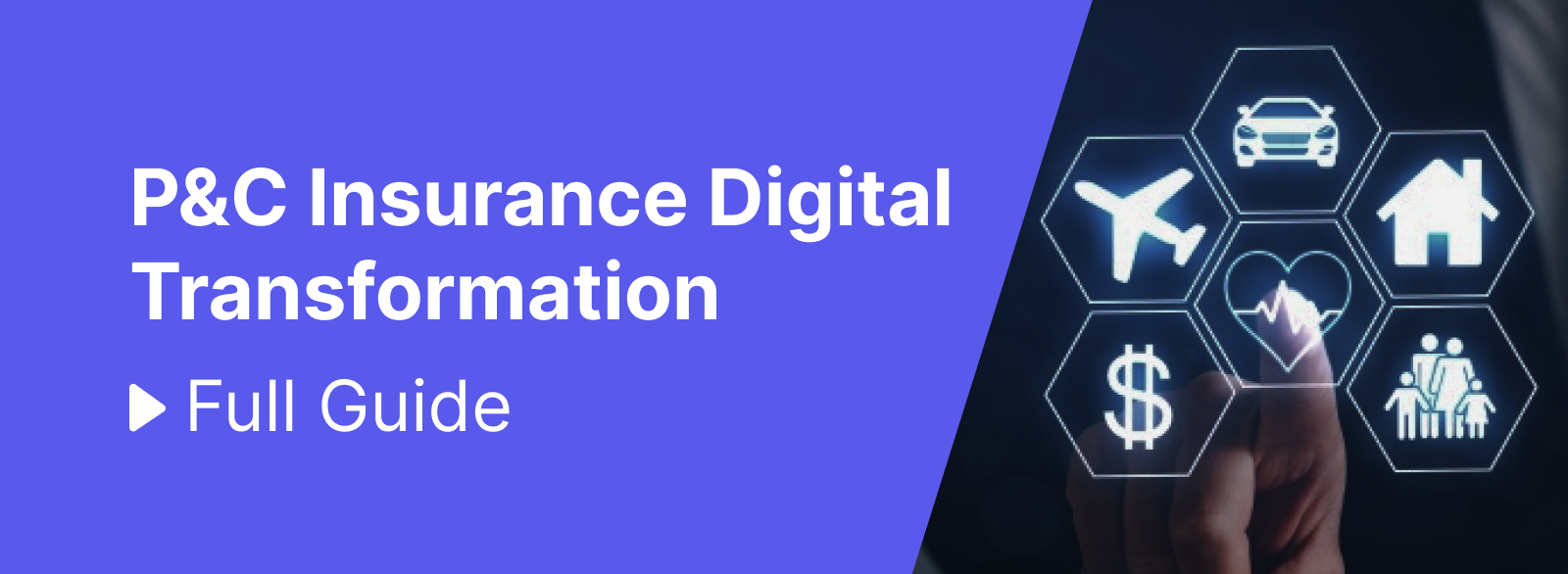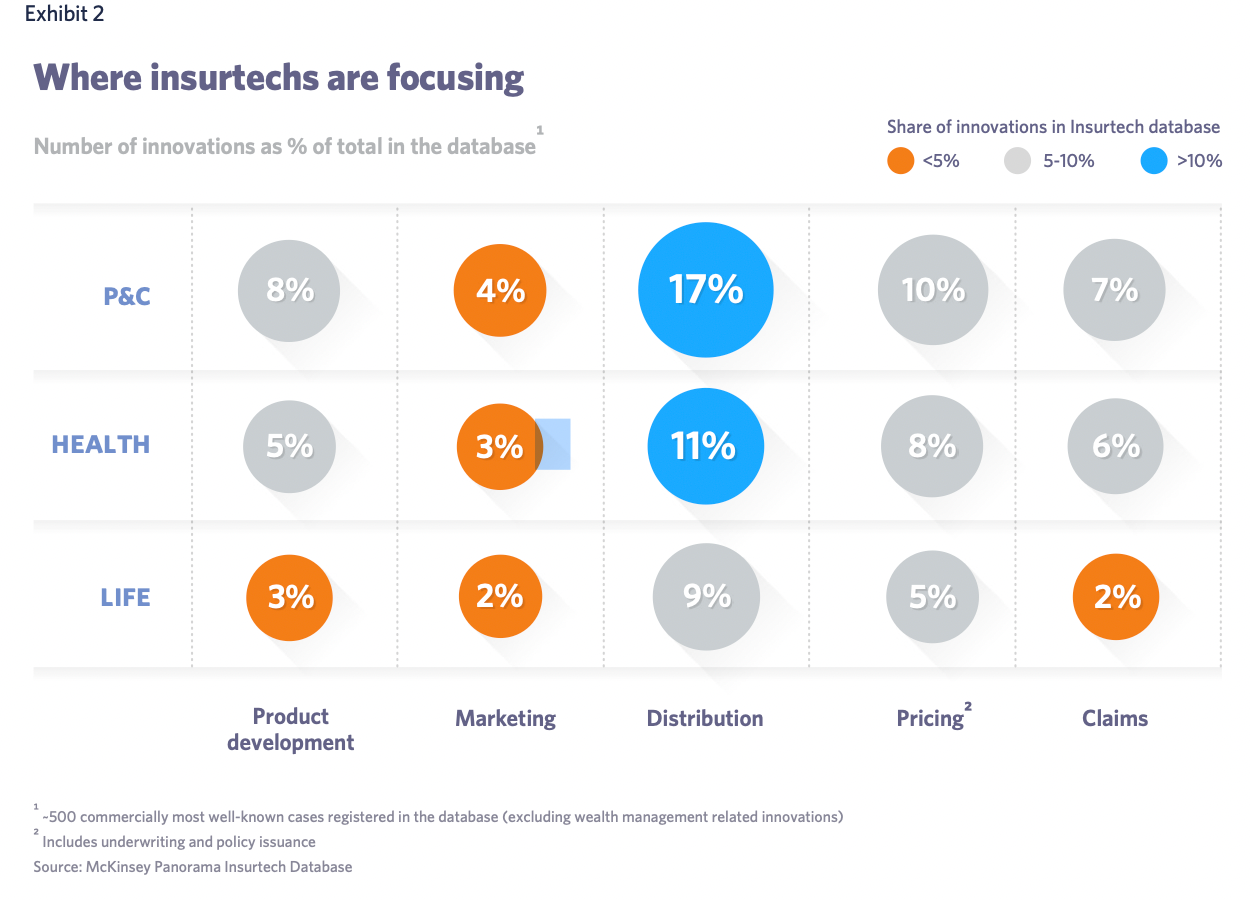P&C Insurance Digital Transformation: Trends, Strategies, and Best Practices for 2025
Learn with AI

Many businesses have embraced the many possibilities digital transformation brings. P&C insurance digital transformation is a particularly unique case due to the industry's highly regulated nature.
According to a survey conducted in 2022 by Publicis Sapient on 250 policyholders from the US and Canada, 36% reported that they switched to providers with a better digital experience. Most noticeably, investment in insurtechs skyrocketed from $500 million in Q2 2014 to about $5 billion in Q2 2021. There are a lot of opportunities for tech-enabled insurance services.
P&C insurance - the more easily accessible sliver of the industry - is the field with a pronounced focus, according to a report from McKinsey.

Source: McKinsey
For now, there is no clear playbook as to how to navigate this exciting territory for insurance companies. Coupled with the ever-rising customer expectations, the demand for personalization, and the disruption of AI technologies, insurance companies are up for a challenge.
In this article, we’ll explore how P&C insurance companies should approach digital transformation, the most prominent trends, strategies, and best practices for digital transformation in insurance, and discover the key to unlock the digital transformation for your company.
Benefits Of Digital Transformation For P&C Insurance Companies
1. Enhanced CX
While older generations still make up most of the insurance customer base, Millennials and Gen Z are showing growing interest in insurance products. To stay relevant, insurers must proactively adapt to their evolving expectations.
Digitalization is increasing customer touchpoints. Rather than relying on fragmented channels, insurers should unify services into a single, integrated workflow to ensure information consistency:

Lemonade is a digital-only P&C insurance company with a web and mobile platform that successfully improved Customer Experience through many innovative digital features.
The backbone of their product includes car insurance recommendations based on driving habits and AI/ML-driven claim reviews.
2. Improved Operational Efficiency
P&C insurance is well-suited for automation due to its standardized, rule-based processes. Automation enables insurers to speed up claims handling and reduce human error.
However, achieving true operational efficiency requires more than automating isolated tasks. It calls for:
- A holistic transformation, integrating front, middle, and back-office functions using modern technologies like APIs, data insights, automation, and connected devices.
- Adding online support features such as chatbots to enhance service. They offer fast, personalized assistance to busy customers while allowing insurance teams to focus on higher-value tasks by reducing routine workload.
3. Better Risk Management
The risk landscape in insurance is evolving. Digital transformation opens new opportunities for risk functions, which enable insurers to identify, assess, monitor, and manage risks more efficiently while lowering costs.
4. New Revenue Streams
Digital transformation can provide P&C insurance companies with significant opportunities to expand their business and generate new sources of revenue. For instance, insurers can leverage their expertise and data to offer value-added services such as risk consulting or cybersecurity to their customers.
5 P&C Insurance Digital Transformation Strategies
1. Adoption of low-code tools
Low-code test automation tools have captured great interest from SMB and Enterprises alike since they're:
- Easy-to-use
- Cost-saving
- Flexible
- Easier to maintain
- Equipped with collaboration features.
These tools enable teams to get results faster for lower resources expended.
Low-code development and testing tool vendors know that they are driving the digital transformation wave, so they always make sure that their tools can fit seamlessly into the vast integration ecosystem of its field. To transform digitally is not just to adopt 1 tool, but an entire ecosystem.
In the P&C insurance industry particularly, low-code tools enable insurers to build, test, and deploy new applications and processes faster, accelerating time-to-market. This is a competitive advantage, but in the near future it surely will become a default, when the importance of speed and agility in insurance is more recognized, and there is no remaining room for traditional way of doing business.
2. API economy
APIs allow for seamless integration between different systems, making it easier for insurers to access and share data across various departments and with external partners.
This, in turn, enables insurers to more quickly develop, test, and launch new products, as well as more efficiently handle claims and underwriting processes.
Of course, the increasing use of APIs also presents new challenges to overcome:
- The system must be able to handle multiple data sources and ensure data quality and security.
- Insurance companies should adopt rigorous API testing to ensure that APIs function correctly, communicate with other systems as intended, and maintain the required levels of performance and security.
3. Customer Self-service
Customer self-service is a key trend in digital transformation for the insurance industry. Customers can perform tasks and access information on their own, without having to interact with a representative of the insurance company.
This trend is being driven by several factors:
- First, customers are increasingly tech-savvy and comfortable with digital technologies, which means they expect to be able to interact with companies in a similar way.
- Second, self-service channels allow companies to interact with customers whenever they want at lower resources.
- Third, self-service channels automate routine tasks and free up staff’s time to focus on more complex issues.
4. Continuous Testing and Comprehensive Quality Assurance
Quality assurance must go hand-in-hand with digital transformation. Since customer experience depends on fast, reliable digital interactions, any system issues can lead to dissatisfaction and loss of trust. Comprehensive QA and continuous testing ensure systems work as intended.

5. Identify areas of opportunity for automation
Automation is the backbone of digital transformation for insurance companies. For P&C insurance companies specifically, automation is critical to meet the demand for digitalized customer experience.

And Katalon is a great solution for this:
-
All-in-One Automation: Create and manage tests for web, API, and mobile apps.
-
Built on Open Source: Powered by Selenium and Appium for flexibility and compatibility.
-
User-Friendly Interface: Ideal for testers with or without coding experience; quick test creation with pre-built frameworks.
-
Cross-Platform Testing: Ensure digital systems work seamlessly across devices, platforms, and operating systems—supporting an omnichannel insurance experience.
-
Comprehensive Test Coverage:
-
Functional and UI testing
-
API testing for third-party systems
-
Visual validations and backend logic testing
-
-
CI/CD Integration: Connect easily with your pipeline (e.g., Jenkins, Azure DevOps) for faster feedback and automated issue tracking.
|
FAQs
Why is digital transformation urgent for P&C insurers?
Customer expectations are rising, insurtech investments are surging, and insurers must modernize to stay competitive and meet regulatory and personalization demands.
How does digital transformation improve customer experience in P&C insurance?
It unifies customer touchpoints, supports personalized interactions, and enables innovative digital capabilities like AI-powered recommendations and fast claim reviews.
What operational benefits do insurers gain through digital transformation?
Automation accelerates claims handling, reduces errors, and supports holistic modernization across front-, middle-, and back-office operations.
How are APIs transforming P&C insurance workflows?
APIs enable seamless system integration, faster product launches, efficient claims and underwriting operations, and require rigorous API testing to ensure performance and security.
Why is continuous testing essential for P&C digital transformation?
Reliable, fast digital interactions are critical for customer satisfaction, making automated and continuous testing necessary to maintain performance across channels.

